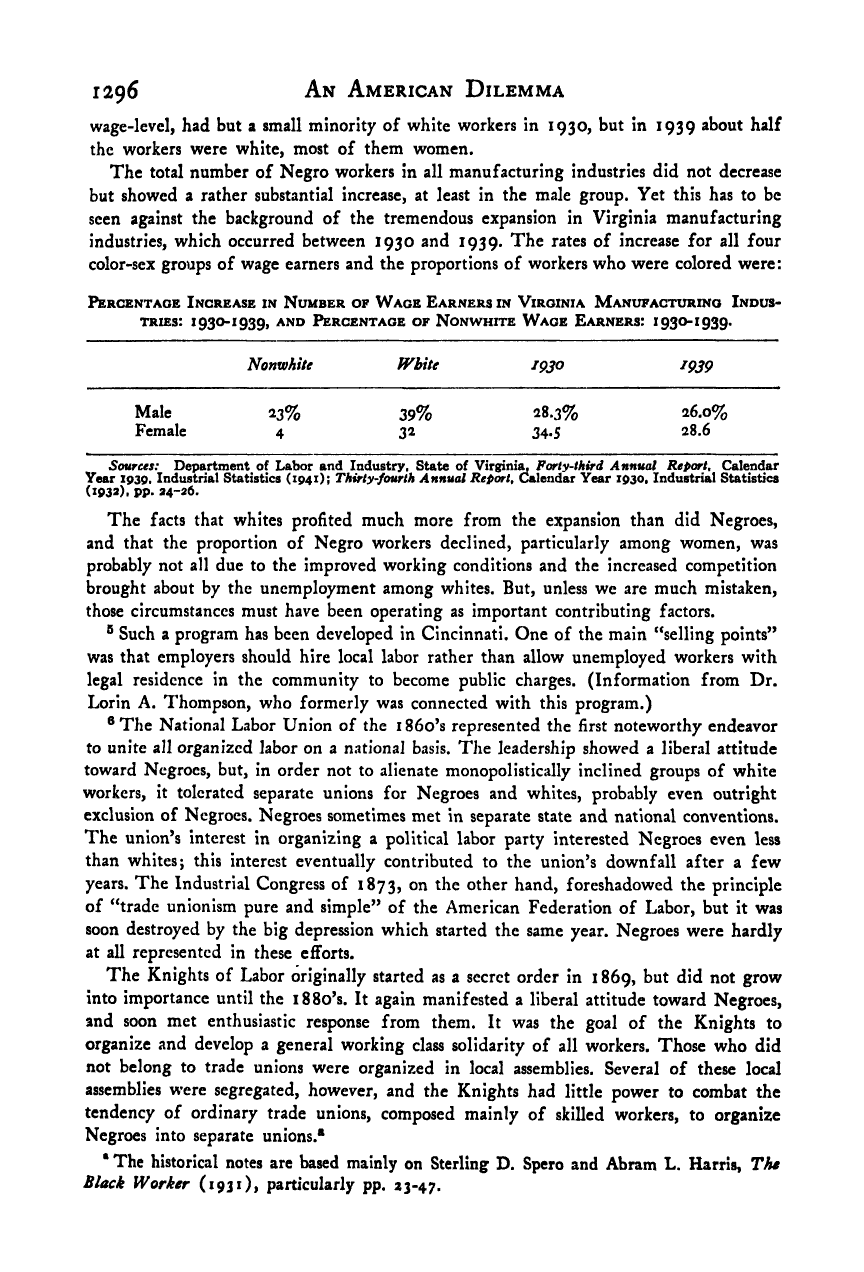Note: Gunnar Myrdal died in 1987, less than 70 years ago. Therefore, this work is protected by copyright, restricting your legal rights to reproduce it. However, you are welcome to view it on screen, as you do now. Read more about copyright.
Full resolution (TIFF) - On this page / på denna sida - Footnotes - Chapter 18

<< prev. page << föreg. sida << >> nästa sida >> next page >>
Below is the raw OCR text
from the above scanned image.
Do you see an error? Proofread the page now!
Här nedan syns maskintolkade texten från faksimilbilden ovan.
Ser du något fel? Korrekturläs sidan nu!
This page has never been proofread. / Denna sida har aldrig korrekturlästs.
An American Dilemma
1296
wage-level, had but a small minority of white workers in 1930, but in 1939 about half
the workers were white, most of them women.
The total number of Negro workers in all manufacturing industries did not decrease
but showed a rather substantial increase, at least in the male group. Yet this has to be
seen against the background of the tremendous expansion in Virginia manufacturing
industries, which occurred between 1 930 and 1939. The rates of increase for all four
color-sex groups of wage earners and the proportions of workers who were colored were:
Percentage Increase in Number of Wage Earners in Virginia Manufacturing Indus-
tries: 1930-1939, AND Percentage of Nonwhite Wage Earners: 1930-1939.
Nonwhite White 1930 m9
Male 23% 39% 28.3% 26.0%
Female 4 3* 34-S 28.6
Sources: Department of Labor and Industry. State of Virginia, Forty-third Annual Report, Calendar
Year X939. Industrial Statistics (1941); Thirty-fourth Annual Report, Calendar Year X930. Industrial Statistics
(1932). PP- 24-26.
The facts that whites profited much more from the expansion than did Negroes,
and that the proportion of Negro workers declined, particularly among women, was
probably not all due to the improved working conditions and the increased competition
brought about by the unemployment among whites. But, unless we are much mistaken,
those circumstances must have been operating as important contributing factors.
® Such a program has been developed in Cincinnati. One of the main “selling points”
was that employers should hire local labor rather than allow unemployed workers with
legal residence in the community to become public charges. (Information from Dr.
Lorin A. Thompson, who formerly was connected with this program.)
® The National Labor Union of the i86o’s represented the first noteworthy endeavor
to unite all organized labor on a national basis. The leadership showed a liberal attitude
toward Negroes, but, in order not to alienate monopolistically Inclined groups of white
workers, it tolerated separate unions for Negroes and whites, probably even outright
exclusion of Negroes. Negroes sometimes met in separate state and national conventions.
The union’s interest in organizing a political labor party interested Negroes even less
than whites; this interest eventually contributed to the union’s downfall after a few
years. The Industrial Congress of 1873, other hand, foreshadowed the principle
of “trade unionism pure and simple” of the American Federation of Labor, but it was
soon destroyed by the big depression which started the same year. Negroes were hardly
at all represented in these efforts.
The Knights of Labor originally started as a secret order in 1 869, but did not grow
into importance until the i88o’s. It again manifested a liberal attitude toward Negroes,
and soon met enthusiastic response from them. It was the goal of the Knights to
organize and develop a general working class solidarity of all workers. Those who did
not belong to trade unions were organized in local assemblies. Several of these local
assemblies w’ere segregated, however, and the Knights had little power to combat the
tendency of ordinary trade unions, composed mainly of skilled workers, to organize
Negroes into separate unions.*
* The historical notes are based mainly on Sterling D. Spero and Abram L. Harris, The
Black Worker (1931), particularly pp. 23-47.
<< prev. page << föreg. sida << >> nästa sida >> next page >>